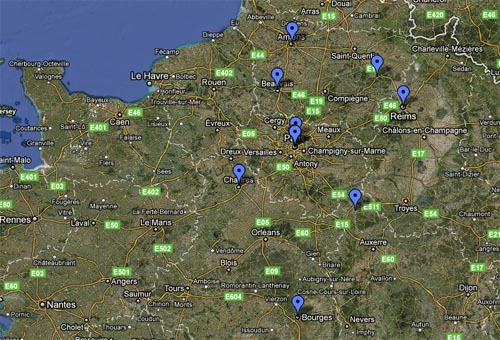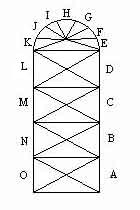| St. Denis (my St. Denis page) |
|
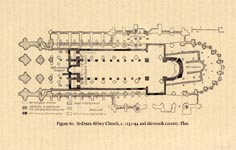
Plan of St. Denis.
|
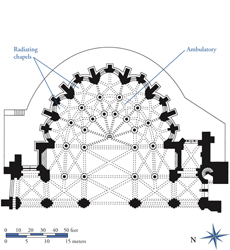
Plan of choir of St. Denis with ambulatory and radiating chapels created by Abbot Suger between 1140 -1144. Excerpts from De Administratione by Abbot Suger.
|
|
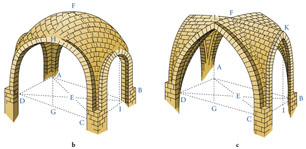
Vaults showing the implications of using pointed ribs as opposed to semi-circular. Note how the example on the left only uses semi-circular ribs which creates a domed effect. For an example of this see the side aisles of Sens Cathedral illustrated below.
|

Exterior of Choir of St. Denis: the lower story with radiating chapels from 1140-1144; flying buttresses and upper story from the mid-13th century/
|
|
|
|
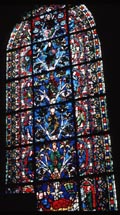
"Tree of Jesse Window." ambulatory of St. Denis, 1140-1144.
|
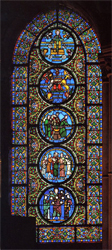
"Anagogical Window," ambulatory of St. Denis, 1140-1144. See the excerpt from De Administratione XXXIV included on the website on Gothic Texts .
|
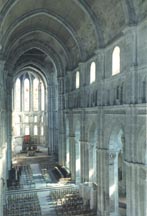
St. Lazare at Autun
|

St. Étienne at Caen
|

The Ambulatory of Paray le Monial
|
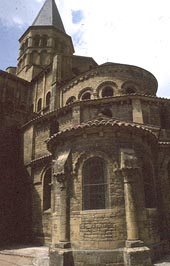
Exterior of the east end of Paray le Monial.
|
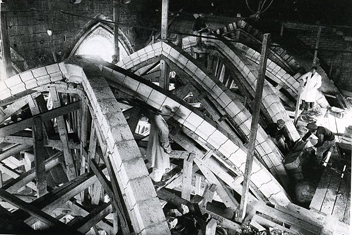
Repairing the vault of Soissons Cathedral after the First World War.
|

Installing wood centering from David Macaulay, Cathedral.
|
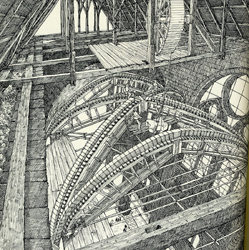
Ribs being installed.
|
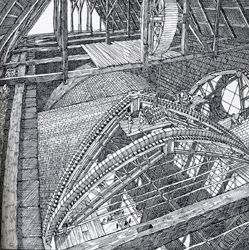
Webbing being installed.
|
| Sens Cathedral |
|

Nave of Sens Cathedral, begun late 1140s.
|
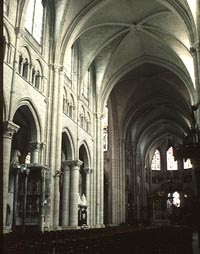
Nave of Sens Cathedral with a sexpartite rib vault. The clerestory windows were enlarged in the thirteenth century, but even with this the windows begin above of the springing of the vault.
|
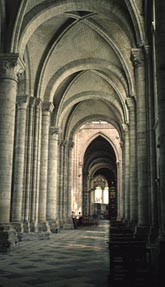
Side Aisles of Sens Cathedral. Note that the transverse ribs and diagonal ribs are semi-circular. This creates a domed effect leading to pockets of space .
|
|
| Notre Dame de Paris |
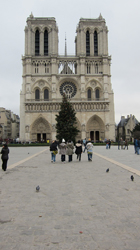
Facade 1200-1250.
|

Nave of Notre Dame de Paris, 1150-80; revised c. 1225-30.
|
|

Sexpartite Rib Vaults of Notre Dame de Paris
|
|
|
| Laon Cathedral |
|
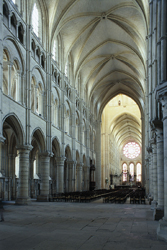
c. 1155-75.
|
|
High Gothic |
Chartres Cathedral : read the excerpt from the Miracles of the Virgin recounting the fire in 1194 and the building of the new church. |
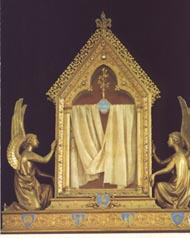
Relic of the Tunic of the Virgin from Chartres Cathedral.
|
|
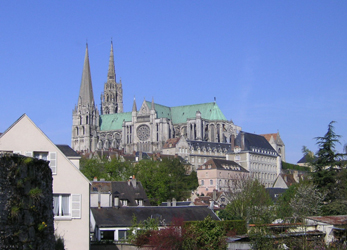
Town of Chartres
|

Chartres nave begun 1194.
|
|
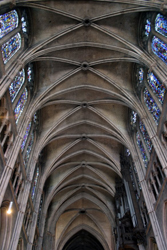
Nave Vault of Chartres: Quadripartite Rib Vaults.
|
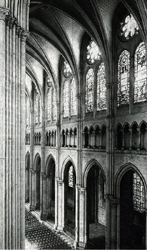
Nave elevation of Chartres: nave arcade, triforium, and clerestory. Note how the clerestory windows begin below the springing of the vault.
|

|
|
|
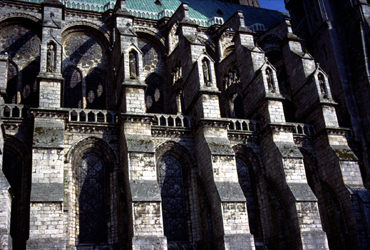
Flying Buttresses from the north side of Chartres Cathedral.
|
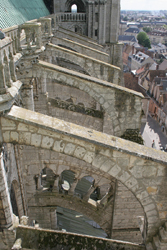
Detail of the flying buttresses from the north side of Chartres Cathedral.
|
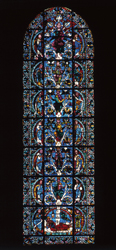
Tree of Jesse Window, west facade of Chartres Cathedral, c. 1150-70.
|
|
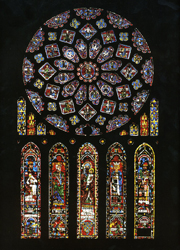
Chartres Cathedral: North Transept Rose Window
|
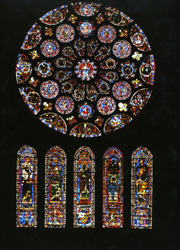
Chartres Cathedral: South Transept Rose Window
|
| Amiens Cathedral |
Amiens Cathedral Web site (Columbia University) |

Amiens Cathedral, nave begun 1220-47.
|
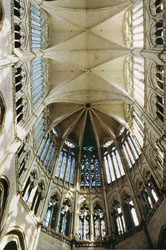
Amiens Cathedral, choir interior, 1258-69.
|
|
|
| Reims Cathedral |
|
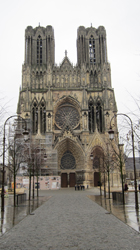
Facade 1230-87.
|
|
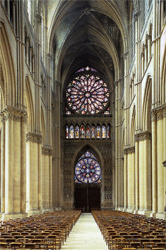
Nave, 1211-c. 1250.
|
|
|
|
|
|
|
Rayonnant Style |
St. Denis: Nave and Choir , 1235-80. 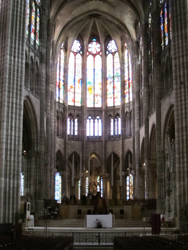 |
|
|
|
| Sainte Chapelle, 1241-1248: |
In 1239, Saint Louis (IX) negotiated with the Emperor of Constantinople for the acquisition of the Crown of Thorns. In 1241, this arrived along with other relics including a piece of the True Cross, lance, sponge, and nail of the Passion of Christ. Sainte Chapelle was constructed to house these relics as the royal chapel as part of the palace. |
|
|
|
|
|
Legend of the stained glass windows :
A : history of the holy relics
B : book of kings
C : Esther
D : Judith and Job
E : Jeremy and Tobie
F : Ezechiel's visions
G : John the Baptist & Book of Daniel
H : Passion |
I : John & Christ childhood
J : Joshua tree and Isaiah
K : Book of Judges
L : Deuteronomy & Joshua
M : Book of numbers
N : exodus
O : Genesis |
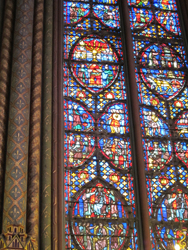
Exodus Window: note the image of the Menorah, tabernacle, and Ark which Moses set up in the Wilderness (Exodus 25:31-40). Moses and Aaron appear beneath these.
|

Detail of Window A with St. Louis holding the Holy Relics. The window is adjacent to the window illustrating the great Old Testament Kings including Solomon (window B).
|

Window A: History of the Relics
|
|
|
|
| |
|
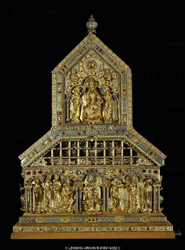
Lower level has Adoration of the Magi with Otto IV (1175-1218, r. 1208-1215) and the Baptism of Christ. The top has Christ in Majesty as part of the Last Judgment. The other end has images of the Passion and Resurrection.
|
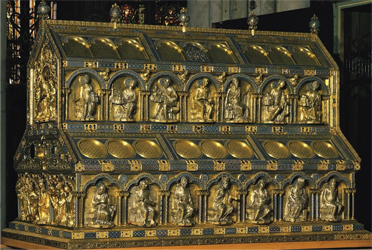
Shrine of the Three Kings, attributed to Nicholas of Verdun, Cologne Cathedral, 1181-1230 (prophets 1181-1191). The bodies of the three magi were "rediscovered" in Milan in1158 and were "translated" (transferred) to Cologne Cathedral in 1164. The reliquary is in the form of what is known as a "chasse" or chest. Consider how the form of the Cologne chasse resembles a basilica with nave and side aisles. Seated Prophets are on the lower level while Apostles and Evangelists are on the upper.
Lessing Photo Archive with excellent images of the work of Nicholas of Verdun.
|
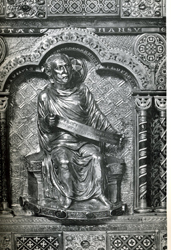
The Prophet Jonah from the Relic of the Three Kings
|
|
|
|
